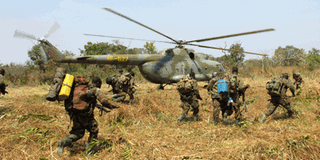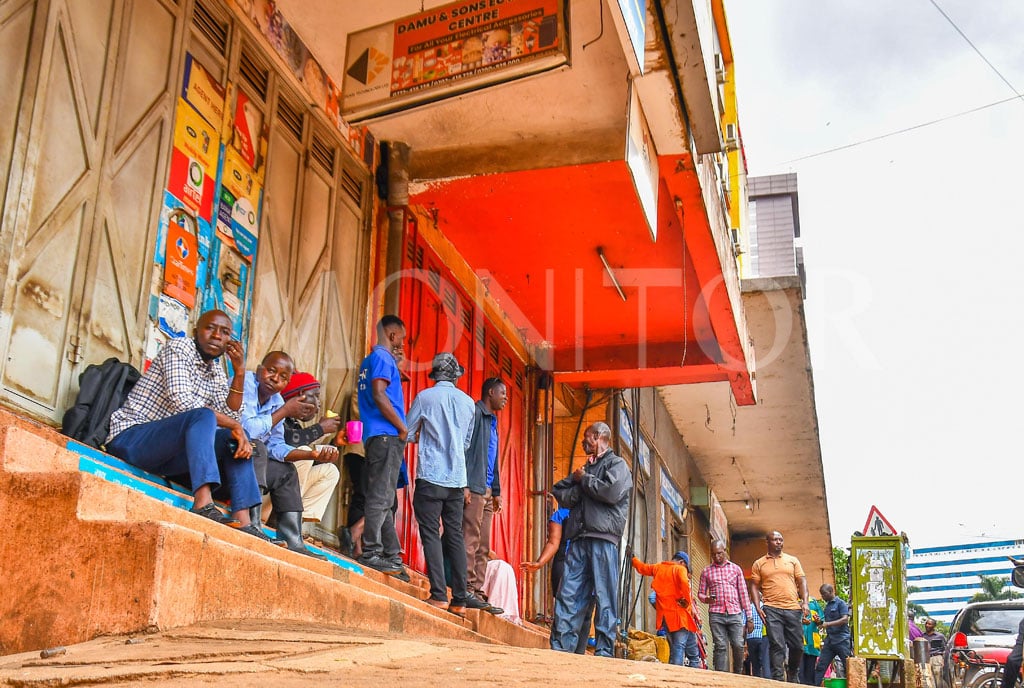The war against Kony is still far from over

UPDF soliders make their way to a helicopter that will take them back from the jungle to their base in Obbo, DR Congo. PHOTOs BY risdel kasasira
What you need to know:
Even though he no longer seems an eminent threat to Uganda, Joseph Kony is still killing people in neighbouring countries. In a mission called Operation Lightning Thunder, UPDF soldiers are trying to hunt him down but the cause is one fraught with technicalities.
Central African Republic (CAR), to the Uganda Peoples Defence Forces (UPDF) fighting squads means the farthest place from loved ones. It also means the place closest to death because of the enemy fire. But even without the war, the life is still cruel. Mosquito bites, wild animals, jungles and walking hundreds of miles because of lack of infrastructure is a daily challenge.
It’s this rough terrain, poor infrastructure and regional politics that have probably prolonged the war against the LRA rebels. There is no single road in an area of 500km, where UPDF squads operate. The area is covered with thick jungles, with rivers running through. There is no presence of life in the area in form of schools, hospitals, roads and clean water.
There is no doubt that this has bogged down the UPDF’s intelligence gathering process and capacity to move fast to the areas where LRA rebeFighting the war alonels are suspected to be operating. Whenever UPDF intelligence gets information on the presence of LRA presence in a certain area, troops are air lifted and dropped in the middle of the jungles to start the hunt. These fighting squads spend months in the jungles until they reach and search the identified location.
When Ugandan journalists visited one of squads under the command of Capt. James Matata, a former LRA fighter, about 70km from Obbo, we were told they had spent one month in the jungles looking for the enemy.
They had walked 150kms to and from the spot they suspected LRA fighters were planning to use to enter DRC. The UPDF operations coordinator in South Sudan, DR Congo and CAR, Col. Joseph Balikuddembe, says if there was a road between Ezo junction, the border point between CAR, South Sudan and DR Congo to Obbo inside CAR where UPDF operations are concentrated, it would it would help UPDF mobile patrols move faster to engage the enemy.“UPDF was able to flush LRA from northern Uganda and South Sudan after the construction of operational roads, deploying zonal forces and mobile patrols. We need the same thing here,” he says.
Fighting the war alone
UPDF seems to be a loner in this war. The regional armies of CAR, DR Congo and South Sudan seem to look at LRA as a Ugandan problem and not a regional one. In fact some of them think UPDF should remain in the vast jungles to fight LRA not because he is a security threat but a Ugandan who has invaded their territory.
The Commissioner of Nzara, in West Equatoria, South Sudan, Mr Elia Richard Bok, says UPDF should not withdraw until he is defeated. He blames DR Congo for not cooperating with UPDF and South Sudan forces to exert pressure on the LRA. “We wonder why he came all the way from Uganda to disturb our people. We have failed to understand this. But to fight and end this war, our neighbours like DR Congo must be cooperative,” he says.
When UPDF launched Operation Lightning Thunder in 2008, the intention was to destroy the enemy but it instead made LRA to retreat into the isolated forests of the DR Congo.
Joseph Kony, the LRA leader, has eluded capture, but some of his commanders have either defected or been killed by the UPDF. His fighters have since killed some 1,300 villagers and abducted at least thousands in the seemingly never-ending war.
With this war becoming a global concern, US president Barack Obama in October this year, authorised the deployment of 100 US troops following the US legislation, to help disarm the LRA and bring its leader to justice.
Use of hi-tech equipment might not help
There is hope that using high-tech military equipment, the US technical team would help with the operations against elusive LRA. This would also reduce the tiring searches of the UPDF squads who walk hundreds of miles in the thick forests, tall grass and cross rivers in the hunt of the indefinable rebel leader.
But expectations that the US troops will quickly capture Kony might be an exaggeration because tracking him down would have been easier if he was using phones or radio walkie talkies to communicate to his commanders.
According to Balikuddembe, Kony has abandoned using electronics to evade interception of his communication. He now uses messengers who walk hundreds of kilometres to deliver messages to his fighters scattered in DR Congo and CAR.
With Kony’s change of communication system, efforts to track him down, are extremely difficult. The American technical team arrived in CAR on December 2, to assist UPDF and other regional forces. Humanitarian workers argue that rather than concentrating on killing and capturing Kony, the plan can also be expanded to include encouraging LRA fighters to abandon the rebellion.
“They need to use a multi-facet approach because tracking him down may not be easy,” James Deng, a worker with Keep Life On, an NGO in South Sudan, says. His argument sounds good but it may be unattainable because they have previously turned down the offers to leave the bush. Despite operating in an unfriendly environment, UPDF has been able to kill 448 LRA fighters, capture 72, forced 151 to defect and rescued 469 civilians in the last three years.
At least 417 sub-machine guns, 12 laptops, 29 VHF radios, 10 generators, 16 High Frequency radios have been recovered. To replenish his fighting force as a result of these deaths and defections, Kony abducts children in DRC, South Sudan and CAR, who are forcefully conscripted into his forces.
“Many of his fighters from Uganda have either been killed or defected. We don’t want to allow him to settle. That’s why he was using abductions to rebuild his force. But we will continue looking for him,” Col. Balikuddembe says. Kony’s decision to appoint his sons, Ali, 20, and his younger brother Salim Saleh to be in charge of his security, is an indication that he either doesn’t trust those close to him or his senior fighters have abandoned the struggle. “According to the latest intelligence we have, they are the ones in charge of his security,” Col. Balikuddembe says.
These defections and deaths have forced the LRA leader to change the way he relates with his fighters. He has dropped his cruel tendencies towards his fighters, which according Richard Komakech, who recently defected, was also causing defections. The last contact UPDF had with the group guarding Kony was on September 24, 100km north of Obbo town, where the UPDF tactical base is located, Col. Balikuddembe said.
Poor service delivery
If LRA is subsequently defeated, insecurity will have ended but poor social service delivery by the governments of CAR, DR Congo and South Sudan remains a big problem in the area.
With little or no presence of government services, the local people in the three countries look to UPDF for medical care and supply of clean water.
At the UPDF headquarter in Nzara, South Sudan, at least 150 patients get free medication on Monday and Thursday. “All complicated cases in this area come here for treatment. Our hospital has become Mulago (Uganda’s national referral hospital),” Warrant officer, Kafeero Asanasio says. Most of the diseases treated in this area are Malaria, malnutrition among the children and hernia. UPDF has also drilled boreholes where residents get clean water.
It remains a tough call for UPDF to fight LRA in this rough terrain. Without infrastructure in place, fighting LRA continues to be laborious. While UPDF has managed gain some success in the fight, the absence of DR Congo, South Sudan and CAR military support means the fight might just go on for long.




